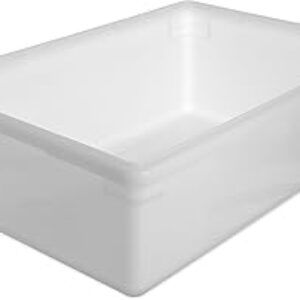Best Large Food Storage Containers (2025 Guide)
Sometimes small just doesn’t cut it. Whether you’re storing bulk pantry goods, prepping large family meals, freezing big batches of soup, or keeping catering supplies fresh, large food storage containers can be a game-changer.
From large airtight food storage containers that keep flour and sugar fresh for months, to large glass containers that can go from oven to fridge and back again, the right choice saves time, reduces waste, and keeps your kitchen organized. These containers usually start at 2 liters (about 2 quarts) and go all the way up to massive commercial sizes over 20 liters.
In this guide, we’ll share our top picks for large containers in every category and material, plus a buying guide to help you choose the right one for your needs.
Best Large Food Storage Containers 2025
Our Top Picks for 2025
Best Overall Large Food Storage Container
OXO Good Grips POP Large Pantry Container
With a 4.5-quart capacity, stackable design, and signature push-button airtight seal, this OXO container is perfect for flour, cereal, or pet food. The clear sides make it easy to see when it’s time to refill.
Pros: Airtight seal, stackable, easy one-handed operation
Cons: Not ideal for liquids
Best For: Pantry staples, dry bulk storage
Best Large Airtight Food Storage Container
Lock & Lock 12L Airtight Storage Box
A true workhorse for bulk storage, this BPA-free plastic container has a four-tab locking system with a silicone seal for leak-proof confidence.
Pros: Leak-proof, high capacity, freezer-safe
Cons: Takes up significant fridge space
Best For: Rice, pasta, pet food, large meal prep batches
Best Large Glass Food Storage Container
Anchor Hocking TrueSeal 16-Cup Glass Container
Tempered glass with a BPA-free locking lid makes this container oven-, microwave-, and freezer-safe.
Pros: Oven-to-fridge safe, non-porous, airtight lid
Cons: Heavy when full
Best For: Big salads, casseroles, batch-cooked meals
Best Large Plastic Food Storage Container
Rubbermaid Brilliance 9.6 Cup XL Container
Crystal-clear Tritan plastic, airtight latches, and a stain-resistant finish make this an everyday favourite.
Pros: Airtight, lightweight, shatter-resistant
Cons: Smaller capacity than some bulk options
Best For: Leftovers, large portions, dry goods
Best Large Food Storage Container for Pantry Use
Progressive International Flour Keeper
Holds up to 5 pounds of flour with a built-in leveling bar for mess-free measuring.
Pros: Airtight, space-efficient, built-in scoop level
Cons: Single-use size
Best For: Flour, sugar, baking ingredients
Best Large Food Storage Container for Freezer Storage
Cambro 22-Quart Square Storage Container
A commercial-grade option for serious storage. With molded-in handles and measurement markings, this container is freezer-, dishwasher-, and NSF-safe.
Pros: Massive capacity, stackable, durable
Cons: Too large for most fridges
Best For: Bulk soups, stews, stocks, commercial kitchens
Best Large Food Storage Container for Commercial Use
Cambro 18-Quart Polycarbonate Round Storage Container
Trusted in restaurant kitchens, this container is built to handle heavy use without cracking or warping.
Pros: Industrial durability, easy-clean design, stackable
Cons: No airtight seal without separate lid purchase
Best For: Bulk ingredients, catering prep
Buying Guide: How to Choose a Large Food Storage Container
Large food storage containers are more than just upsized versions of everyday tubs – the right one can save space, reduce waste, and make bulk storage or meal prep far easier. Choosing well comes down to a few key considerations: capacity, material, lid style, shape, and cleaning convenience.
Capacity and Dimensions
Capacity and dimensions should be your first decision point. In the storage world, “large” can mean anything from 2 liters (about 2 quarts) to 20 liters (over 5 gallons). For home kitchens, containers in the 2-5 liter range work well for pantry staples like flour, sugar, rice, and cereal. Fridge storage for big salads or leftovers is usually easiest with 3-6 liter containers, while freezer batches of soups and stews might need 4-10 liters.
For commercial kitchens and catering, capacities of 10 liters or more are common, but they can be heavy and unwieldy for everyday domestic use. Always measure the space you plan to store them in – a container might hold the perfect amount but still be too tall for your fridge shelf.
Materials
The material you choose affects durability, safety, and versatility. Plastic is the most common for large containers because it’s lightweight, shatterproof, and affordable, but it can stain or absorb odors over time. Look for BPA-free, food-grade options, especially if you’ll store food long-term.
Glass is heavier and breakable but completely non-porous, oven- and microwave-safe, and perfect for acidic foods like tomato sauces. And stainless steel offers unmatched durability and is great for outdoor or catering use, but it’s opaque, so you can’t see what’s inside, and it can’t go in the microwave – not so great if you’re trying to find a specific batch of leftovers.
Lids and Seals
Lid type and seal quality are crucial if freshness or leak prevention matters. Airtight lids with silicone gaskets lock out air and moisture, making them ideal for dry goods or freezer storage. Locking lids use tabs or clips to secure the seal, adding an extra layer of protection for liquids or travel.
Push-button seals are quick to open and close, which makes them ideal for containers you access daily. Commercial snap-on lids are fast and convenient, but they’re rarely fully airtight.
Stackability
The shape and stackability of a large container can make or break your storage efficiency. Square or rectangular containers tend to maximise space in pantries and fridges, and they stack neatly without gaps.
On the other hand, round containers are better if you need to stir or scoop directly from them, but they waste more space when stored side by side. Some large containers are designed to nest when empty, saving space between uses.
Cleaning
Ease of cleaning becomes more important the larger a container gets. Many plastic and glass models are dishwasher-safe, but make sure they fit comfortably in your machine before you commit.
Removable seals are a bonus because they allow you to clean every crevice, preventing mold or bacteria buildup. Wide openings also make hand-washing easier, especially if you’re cleaning a container in a small sink.
Usage
Finally, consider where and how you’ll be using the container. For home kitchens, aim for a balance between capacity and manageability, with multi-purpose designs that can handle freezer, fridge, and possibly microwave use. For commercial use, focus on durability, large capacities, and compliance with food safety standards – commercial-grade polycarbonate or stainless steel are excellent options.
If you take the time to match size, material, and lid design to your needs, a large food storage container can do more than just hold ingredients – it can keep them fresher, make your kitchen more organised, and even save you money by reducing waste.
Large Food Storage Container FAQs
What size is considered a large food storage container?
Typically anything over 2 liters (about 2 quarts) is considered large, with commercial sizes exceeding 20 liters.
Are large food storage containers safe for the freezer?
Yes, if labeled freezer-safe. Look for BPA-free plastic or tempered glass to prevent cracking.
What’s the best material for large airtight food storage containers?
BPA-free plastic for lightweight portability, or glass for oven-to-fridge use.
Can large glass food storage containers go in the oven?
Yes – if they’re made from tempered or borosilicate glass and are clearly marked oven-safe.
How do you clean large food storage containers?
Dishwasher-safe models are easiest to maintain. For hand-wash, use a bottle brush for deep corners.


